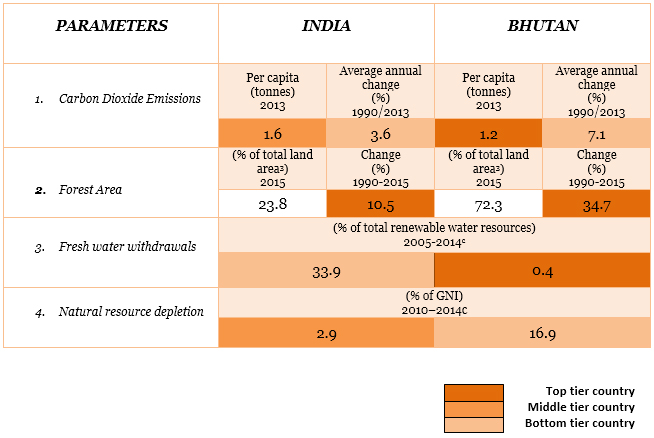



Bhutan emits around 1.5 million tonnes of carbon annually, but thanks to its massive tree cover, 72% of the country is still forested allowing the country to become a carbon sink. Being a carbon sink means that Bhutan absorbs over 6 million tons of carbon annually while only producing 1.5 million tons. While no other country has even achieved becoming carbon neutral, Bhutan has managed to be carbon-negative!
Bhutan has managed to do this by-
India being a highly populous and a growing economy has managed to increase its, CO2 emissions by about 90% since 1970; with emissions from fossil fuel combustion and industrial processes. So Bhutan fares well here.
Between 1990 and 2010, Bhutan lost an average of 10,700 ha or 0.35% of forests cover per year. However between 1990 and 2010, it gained 7.1% of its forest cover or around 214,000 ha. This small but significant transition from net loss to net increase of forest cover is attributed to a long tradition of environmental preservation policies and measures.
India too isn’t far behind in its increasing forest cover venture it stands eighth in terms of annual forest gain and has increased its forest cover by 1%.
India has not been as lucky as Bhutan, as Bhutan is well cloaked with topographical advantages when it comes to fresh water withdrawals.
The whole of Bhutan falls in the eastern Himalayas and the country’s freshwater systems (glaciers, lakes, rivers, marshes, etc.) is an integral part of the headwaters of nearly 580,000 Km2 of the Brahmaputra river basin. Further, 200,000 megawatts (MW) hydropower potential of the basin is envisaged as key to fuel the economy.
India’s hydropower plants still have a long way to go owing to the geography of the country. Instead Bhutan helps India with its ever increasing water demand. Despite this, the value shoots to a high of 33.9 for India.
Glaciers cover about 10% of the area of Bhutan, providing an important source of renewable water allowing it to minimize its water withdrawal statistics to a mere 0.
But all is not roses; sewage and trash have contaminated the water supply for 1,000 households around the area of Ngabiphu, in Bhutan. Habitat loss and degradation, mainly due to sedimentation, pollution (from urban, agricultural, and industrial sources), forest clearance, and the development of hydropower dams are also visible.
Further Bhutan, sandwiched between the two most populous nations on Earth, India and China suffers for their sins. Glaciers are beginning to melt, flash floods and heavy rains—and even droughts—are common, and temperatures are climbing.
Bhutan is undergoing a demographic shift. The rising young population no longer wants to work on the land and is moving to the cities in search of white-collar jobs, all the factors contributing to inefficient management of natural resources, reaching a value of 16.9.
In India rapid economic development, increased urbanization and a growing population all continue to drive up the demand for heavy utilization of natural resources but India has successfully come up with many initiatives to curb the ill effects efficiently and bring down the value to 2.9.
Both the countries are in a close competition and have gained the world’s respect and attention for their own set of sustainable initiatives. In the coming years they have a big reputation to uphold, and luckily even bigger plans to do so.
Published on: Mar 21, 2018
1. The mandate for blending Compressed Biogas (CBG) with natural gas has come into effect…
Andhra Pradesh is striving towards greening its energy sector with quite some speed. In a…
With an objective to bolster India’s green energy goals, a Tripartite Agreement has been signed…
The Union MNRE Minister Pralhad Joshi launched the Green Hydrogen Certification Scheme of India (GHCI)…
India’s energy conglomerate Bharat Petroleum Corporation Limited (BPCL) has commissioned a 5MW green hydrogen plant…
In a historical development, the European Space Agency (ESA) has successfully launched its pioneering ‘Biomass’…